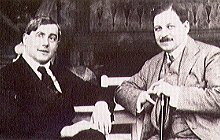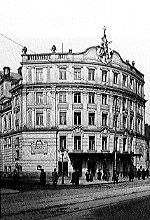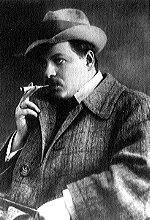| [terug
naar inhoud Kálmán-biografie]
[naar
literatuurlijst]
inhoud:
|
BIOGRAPHY first part (1882-1915)
introduction

Emmerich Kálmán
Emmerich Kálmán was the last Grand Master of the Viennese
operetta. For two decades, from 1909 to 1930, his compositions
dominated the Viennese entertainment theaters and all small and big stages
of the German speech area. Titles like „Die Csárdásfürstin",
„Gräfin Mariza" and „Die Zirkusprinzessin" belong even
today, four decades after his death and in a time, where the operetta is
in decline, to the basis of the operetta repertoire. Much more than his
compatriot Franz Lehár,
Emmerich Kálmán brought in the Hungarian element into the
operetta music. Kálmán tried to break up the artistic paralysis
of the musical entertainment theater around the turn of the century and
to give it a new direction through his characteristic melodiousness full
of elegiac sentiments, through refined sound effects and musical dancing
form of the present.
In 1938, Emmerich Kálmán was expelled by
the nazi myrmidons from his second home Vienna. After World War II, the
composer did return to Europe, but he received, like so many of his colleagues,
no official invitation to take up residence again in Austria. He spent
the last years of his life in Paris, the city, where he had found his first
refuge after the expulsion from Vienna.
Imre Kálmán: Youth at Lake Balaton and studies in Budapest
(1882 - 1909)
Imre Kálmán (he changed his first name in Vienna)
was born on October 24th 1882 in Siófok, a bathing resort
on the east bank of the Lake Balaton (by the way, he held that the family
did not agree whether it was October 24th or 25th). Kálmán
came from an upper middle-class family (the father was a well-off businessman),
which made often music. His sister Vilma was a good pianist and
in the summers a violinist of the orchestra of the Budapest opera house
was often their guest. He noticed the musical talent of little Imre. After
the construction of a theater in the small town of Siófok, the adolescent
got for the first time in touch with the theater and became acquainted
with the Viennese music at the performance of the „Fledermaus". The ten-year-old
boy, who was top boy at the village school of Siófok, went to secondary
school in Budapest.
In the course of Imre's time at the secondary school, the family
- in the meantime impoverished by a business misfortune - had to leave
Siófok. The parents moved into a small apartment in Budapest. They
had all to contribute to the family maintenance, also Imre just fourteen
years old. He gave private lessons to schoolmates. „At that time, the
great longing for music has grabbed me. It urged me to forget my daily
worries through music. I wanted so much to study music! As long as my parents
had asked me to study music, I did not wanted to - now, that there was
no more piano, no more money, I wanted to study music at any price, to
become musician."
Kálmán heard „Harold en Italie" by Berlioz, bought
Robert Schumann's musical works and saw his future as piano virtuoso. But
an affection of the hand put an end to his dreams. At the end of his time
at secondary school, he met Albert Szirmai, whose operettas were later
also performed in Vienna.
Musical studies and first compositions
At the conservatory of Budapest the famous professor Hans Kössler
taught him musical theory and composition - at the same time Ernö
von Dohnány, Béla Bartók et Zoltán Kodály
studied
also here. Kálmán did not finish the law studies he began
at the same time. For a while, he worked as music reviewer at
„Pesti
Napló", one of the most important Hungarian newspapers.

Franz Molnár and Emmerich Kálmán
colleague at the Hungarian newspapers
Works by Kálmán were performed for the first time on June
8th 1903 in Budapest: A „scherzando" for string orchestra, the
first movement of a piano sonata and some smaller compositions for piano
were played on the occasion of a school concert. A year later, the symphonic
scherzo „Saturnalia" was performed in a concert of the philharmonic orchestra
of the Budapest opera house.
From 1904 to 1906, scholarships allowed Kálmán
study visits in Bayreuth, Munich and Berlin, and in Budapest he was awarded
the Franz-Joseph prize for his lieder. But he could not find a publisher
for his works, much less earn his living out of composing. Financial success
was to be expected only at the entertainment theater and so Kálmán
applied himself to light entertainment.
In 1906, his musical comedy „Das Erbe von Pereszlény"
was performed for the first time. It had a moderate success. But extremely
popular became a topical song „Én vagyok a Fedák Sári
szobalánya" („I am the parlormaid of Fadák Sári")
parodying the popular diseuse Fedák Sári of Budapest.
Austria-Hungary at the Viennese entertainment theater:
The „compensation operetta"
The Viennese operetta is a child of the late 19th century. The „golden
era" of its history crowds together in two decades. In 1871,
Johann
Strauss
tried his hand with „Indigo und die vierzig Räuber"
for the first time at the theater. Already two years later, he composed
with the „Fledermaus" the Viennese operetta absolute: Here, comic opera-like
dramaturgy associated with Viennese farce and Viennese dance music into
a new form, which remained binding for the next years and was developed
by Franz von Suppé, Carl
Millöcker, Carl Zeller and Strauss himself. In 1885, the „Zigeunerbaron"
by Strauss became important for the further history of the genre, the „compensation
operetta", as it was called soon. For the first time a great operetta was
set in Hungary, Viennese and Hungarian elements were equally side by side
in the music, as it corresponded to the political reality in the Danubian
monarchy after the compensation concluded in 1867 and Franz Joseph
having been crowned Hungarian king.
Already early in the nineties of the last century, signs of a
crisis appeared in the Viennese musical entertainment theater. The „Vogelhädler"
by Carl Zeller (1891) was the last successful work of the „golden
era" of the Viennese operetta. The musical entertainment lost a deal of
its level and drifted more and more in the direction of „honky-tonk". The
great traditional Viennese theaters, the Theater an der Wien and the Carltheater,
got into financial difficulties, changed their owner, new attractive works
were lacking. The great composer were dead: Johann Strauss died on June
3rd 1899 and as a symbol of the end of this epoch also Carl Millöcker's
life ended in the night of New Year's Eve 1899. „Wiener Blut" by Johann
Strauss, early dance compositions still arranged under the direction of
the composer and performed for the first time on October 26th 1899,
was one of the greatest successes of the classical era.
Franz Lehár
helped the Viennese entertainment theater out of the crisis. His first
operettas „Wiener Frauen" and „Der Rastelbinder" (both 1902)
showed, although in the form folk play-like, already a totally new melodic
temperament molded less by Hungarian than by Slavic sentiment.
December 30th 1905 marks the begin of the „silver era"
of the Viennese operetta: This evening, the „Merry Widow" by Lehár,
one of the most successful operettas of all time, was performed for the
first time at the Theater an der Wien. The comic opera-like elements of
the classic operetta were repressed to the advantage of a new sensuality
and eroticism: The „dance operetta", with stories set in the present,
was born
.
„All' ungherese" in the Viennese music
The interest of Austrian composers in Hungarian elements in the music dates
back far. Already in the Viennese classicism „All' ungherese" was
popular with the public, as examples of Joseph
Haydn or Franz
Schubert show. The Hungarian music achieved a higher level of notoriety
only in the years of the national „spring" of the several nations
of the monarchy.
The Hungarian elements of the Viennese operetta originate from
the so-called „verbunkos", lieder and dances played and sung in
the 18th century on the occasion of recruitments of soldiers. Different
elements of the folkloric music merged then with elements of art music.
Gypsy orchestras spread this melodies also throughout cities, virtuosos
attended to them, until they were stylized into a national-Hungarian music.
Also the csárdás, which appears for the first time
in an operetta in the „Fledermaus", has developed from the „verbunkos":
A slow part („Lassú") is followed by a fervent allegro. The typical
instrument of the csárdás was the cimbalom (cymbalo), which
Strauss used neither in the „Fledermaus" nor in the „Zigeunerbaron",
but only in the ballet music for „Ritter Pázmán",
his only opera - so the instrument immediately „accepted" at the
court opera. All these elements were adopted, as part of a bourgeois musical
culture, also by Emmerich Kálmán in his operettas.
First Viennese successes and move to Vienna (1909 - 1912)
With the première of „Tatárjárás" in Budapest
the course was set for Emmerich Kálmán's future: „One
evening in the middle of the performance the old theater doorman rushed
up to me and announced stuttering that three gentlemen from Vienna had
looked for me," he relates in his biographical sketch. „»From
Vienna, please«, he repeated, which was for him obviously the quintessence
of all bliss. They would sit in the first row - and would want to talk
to me in the interval. Urgent, please. And right, after the end of the
first act they hurried up to me with flaming red faces and introduced themselves:
Wilhelm Karczag and Karl Wallner, directors of the Theater an der Wien,
and Leo Fall, composer of the „Dollarprinzessin"." The excitement was quite
understandable, because with Karczag and Wallner the directors of the most
important and richest in tradition theater of the German speech area were
interested in the young Hungarian. They quickly came to terms on the conditions
of a preparation, Robert Bodanzky was charged with the German preparation
of the text. „Ein Herbstmanöver" - so the title of the operetta in
the German version - reminds one a little of „Merry Widow" by Franz
Lehár: Once, a baroness, recently widowed, has been in love
with a first lieutenant of the hussars, but had to marry someone else.
Now, after the death of her husband, that first lieutenant takes part in
a maneuver near her castle. After many complications and disappointments,
they finally become man and wife.

The "Theater an der Wien (1901)"
Kálmán had to supervise the rehearsals at the Theater
an der Wien. He moved from Budapest to Vienna into a small apartment
in the house Alserstraße 18 in the 9th district. At that time, he
did not know that he left Budapest for ever. The première of the
new operetta was expected eagerly. On the night of January 21st 1909,
the enthusiasm of the public at the Theater an der Wien exceeded all expectations.
The interpreters of the lovers Grete Holm and Otto Storm had a large part
in the success. With Max Pallenberg as reserve cadet Wallerstein a new
inspired comedian was discovered. Later he had great successes especially
in Germany. The character of the partition met with great approval: The
elegiac waltz themes („Seh' ich dich strahlen", „Frauenherzen sich gewinnen"
and „Zauber der Liebe") and the racy marches („Ziehen die Husaren ein",
„Heissa Husaren, stürmt jetzt die Scharen") with the minor key clouding
typical for Kálmán forced many repetitions. But a real „hit"
became the Wallerstein's couplet „Das ist mein Freund, der Löbl,
für den hab' ich ein Faible". Up to this day, it is the musical
label of this operetta, which had 265 performances at the Theater an der
Wien.
The work brought the young beginner in Vienna an unparalleled success,
which came also in the next productions in Graz, Hamburg and Berlin. Already
this year, it was put on the stage in New York entitled „The Gay Hussars",
it followed Stockholm and London's „Adelphi-Theatre", next year
Copenhagen, then Genoa and Marseilles. There were performances in Russia,
Poland, Prague and Australia. The first step towards worldwide fame was
made.
The royalties flowed abundantly, but the composer continued all his
life to be modest and thrifty, aware of the great financial problems of
his youth. Soon after the première of „Herbstmanöver", Kálmán
met the woman who should spend the next seventeen years by his side: Paula
Dworczak, born in Salzburg. He moved from Alserstraße into a
three-room apartment in the 4th district, Paulanergasse 12. Here, he lived
with Paula without marrying her. For the moment, Kálmán composed
once more for Budapest, his friend Bakonyi wrote the libretto for „Az obsitos"
(German title: „Die Urlauber"). In 1910, the operetta was performed
for the first time at Vígszínház and later revised
several times.
The music theater in Vienna
The Viennese theater scene had changed a lot at the beginning of the 20th
century. All the great new speech theaters, which were built around the
turn of the century, could not hold their own and were turned into opera
or operetta houses. In 1907, the Kaiserjubiläums-Stadttheater
became the Volksoper (holding 1890 people), in 1908, Wilhelm Karczag and
Karl Wallner leased the Raimundtheater (holding 1531 people) as second
house in addition to the Theater an der Wien (holding 1336 people). Operettas
were finally played at both houses. There were also the Carltheater (holding
1121 people) and the „Neue Wiener Stadttheater" (holding 1400 people).

"The Wiener Bürgertheater"
In 1905, the Wiener Bürgertheater was founded at Vordere
Zollamtsstraße 13 (today central office of the Bank Austria), holding
1134 people. Six years later, the director, Oskar Fronz, applied for a
license to perform music dramatic works. Later, this theater was very important
for Edmund Eysler, some of his greatest successes were performed here for
the first time.

The Johann-Strauß-Theater
In 1908, the Johann-Strauss-Theater, one of the most beautiful
houses in Vienna, opened its doors at Favoritenstraße 8 in the 4th
district. The house in the neo-baroque style of the period of promoterism
held 1192 people. Till the twenties, the theater was the home of Emmerich
Kálmán's works.
From 1910 to 1930, a total of eight to ten thousand people
had to be enticed every day to go into operettas in Vienna to fill all
the houses.

Portrait
Emmerich Kálmán ca. 1912
On the way to worldwide fame (1912 - 1915): „Der Zigeunerprimas"
The operetta business did not tolerate long breaks: The public wanted to
see new plays - only when the composer was really successful, he could
afford to present his works at longer intervals. After „Der Gute Kamerad",
two new works by Kálmán were performed at once in Vienna:
At the Theater an der Wien „Der kleine König" and at the Johann-Strauss-Theater
„Der Zigeunerprimas" by Julius Wilhelm and Fritz Grünbaum, a subject
representing the type of the „Hungarian operetta" even more than
„Herbstmanöver". The libretto treated a lot of stereotyped ideas of
Hungarians and Gypsies:
Pali Rácz is an old primas. His son Laczi has also become a good
musician, he even studied at the conservatory. But the father does not
appreciate his ability. Pali receives an invitation to perform in Paris.
At first, he does not want to accept it, only when they want to engage
his son after that, he agrees and hurts Laczi so much that he leaves the
house. In Paris, father and son become reconciled after many partly amorous
intrigues. Pali even presents his precious Stradivarius to Laczi (in the
first version he still threw it into the fire...).
At the première on October 11th 1912, Kálman's
music sent into raptures. Alexander Girardi as Pali Rácz was the
star of the performance. In the first season, it had a run of over 300
performances. All the Viennese dance bands played the waltz themes „Du,
du, du, lieber Gott, schaust zu", „Die alte Stradivari" and „O komm
mit mir und tanz mit mir ins Himmelreich hinein". The „Dorfkinderwalzer"
composed of melodies of the operetta is popular piece even today.
The „Zigeunerprimas" was also staged at many theaters at home and abroad.
But the „Kleine König", performed for the first time on November
27th 1912 at the Theater an der Wien (text by Károly Bakonyi
and Ferenc Martos, German by Robert Bodanzky), was not granted success.
Kálmán composed his next operetta for Budapest again: „Zsuzsi
kisasszony" („Fräulein Susi"). It had no sweeping success neither
at the first performance in February 1915 nor adapted as „Miss Springtime"
in New York in 1916. It was only successful in the third adaptation
entitled „Die Faschingsfee" in Vienna in 1917.
|